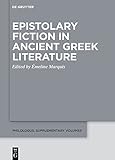Epistolary Fiction in Ancient Greek Literature / ed. by Émeline Marquis.
Material type: TextSeries: Philologus. Supplemente / Philologus. Supplementary Volumes : Zeitschrift für antike Literatur und ihre Rezeption ; 19Publisher: Berlin ; Boston : De Gruyter, [2023]Copyright date: ©2023Description: 1 online resource (VIII, 243 p.)Content type:
TextSeries: Philologus. Supplemente / Philologus. Supplementary Volumes : Zeitschrift für antike Literatur und ihre Rezeption ; 19Publisher: Berlin ; Boston : De Gruyter, [2023]Copyright date: ©2023Description: 1 online resource (VIII, 243 p.)Content type: - 9783110996241
- 9783110984262
- 9783110983739
- 883.0109 23
- PA3014.L37 M37 2023
- online - DeGruyter
- Issued also in print.
| Item type | Current library | Call number | URL | Status | Notes | Barcode | |
|---|---|---|---|---|---|---|---|
 eBook
eBook
|
Biblioteca "Angelicum" Pont. Univ. S.Tommaso d'Aquino Nuvola online | online - DeGruyter (Browse shelf(Opens below)) | Online access | Not for loan (Accesso limitato) | Accesso per gli utenti autorizzati / Access for authorized users | (dgr)9783110983739 |
Frontmatter -- Preface -- Content -- Introduction: Epistolary Fiction versus Spurious Letters -- Part I: Authentic Fictions -- Saturnalische Fiktionen. Lukians Τὰ πρὸς Κρόνον als karnevaleskes Textcorpus -- Temps, mythe et littérature dans les Lettres d’Alciphron -- Der komödische Brief – Poiesis und Gattungshybride in Alkiphrons Hetärenbriefen -- Order and Structure in the Letters of Philostratus -- Poor, Foreign, and Desperate: Philostratus’ Fictional Letter-writer Persona in the Erotic Letters -- The Letters of Aristaenetus: Attribution, Dating, Cultural Background -- Part II: Disputed Fictions -- Vom Topos zum Ethos: Überlegungen zum Umgang mit tradiertem Gedankengut in den Phalarisbriefen -- Der „alte gute“ Euripides der „Euripidesbriefe“, oder: Sinn und Zweck einer „biographie corrigée“ -- Ea omnia super Christo Pilatus […] Caesari tunc Tiberio nuntiauit (Tertullien, Apol. 21). Quand les éditeurs fabriquent une lettre de Pilate : l’autonomisation d’une fiction épistolaire -- „Von Syrien bis Rom kämpfe ich mit wilden Tieren ...“ (IgnRom 5,1). Die ignatianischen Briefe als literarische Fiktion aufs Neue verteidigt -- Redaktionsgeschichte und Fiktion in der Briefsammlung von Nilus Ankyranus -- Index nominum -- Index rerum -- Index locorum
restricted access online access with authorization star
http://purl.org/coar/access_right/c_16ec
Ancient epistolary fiction is a still largely under-explored field of research, at the intersection of studies on epistolography and on pseudepigraphy. The present volume sketches out a broad panorama of ancient fiction in letters. It covers a large period of time up to late Antiquity, with a main focus on letters from the imperial era. Epistolary fiction is examined as a mainly Greek phenomenon (there are few Latin equivalents) that was characteristic of both pagan and Christian literature. The material investigated falls within two categories: fictional letter collections from well-known authors of the Second Sophistic and their successors (Lucian, Alciphron, Philostratus, Aristaenetus); letters attributed to famous historical or legendary characters (pseudonymous letters). Focusing on the specific features of epistolary fiction, the book aims to analyse its forms, its functions as well as its effects. It gathers a series of 11 state-of-the art essays, all tackling the same important issues: the manuscript and printed tradition, the form of epistolary fictions and the universe they build, the arrangement of the letters and their overall structure, the relation between the author and his external readers.
Issued also in print.
Mode of access: Internet via World Wide Web.
In English.
Description based on online resource; title from PDF title page (publisher's Web site, viewed 06. Mrz 2024)


